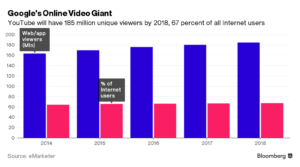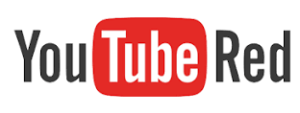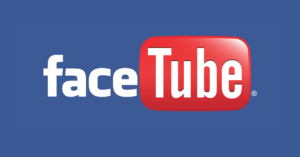YouTube: How to Continue Digital Dominance?

YouTube is the current king of digital video. However, as we’ve learned in DIG and in BSSE, no single strategy is successful forever and disruptors often get disrupted themselves as industry landscapes change. How can YouTube remain dominant as giant platforms with valuable user data like Facebook and Amazon enter the video space?
The World’s Primary Video Destination
YouTube has come a long way since former PayPal employee and YouTube co-founder Jawed Karim uploaded the site’s very first video, Me at the zoo, back in 2005. While YouTube was known early on for its low quality, short-form user-generated content, the video platform was acquired by Google in 2006 and has evolved to feature longer-form and more premium content from partners like traditional studios and TV networks as well as to develop its own original content for its YouTube Red subscription service.
Today, YouTube is the world’s biggest video platform. YouTube reaches over 1 billion users a month, with 15-20% of those users having uploaded a video at some point in time. 300 hours of video are uploaded to YouTube every minute and 3.25 billion hours of video are watched per month. This viewership represents about 10% of overall video consumption, making YouTube’s reach broader than any broadcaster or cable network in the world. [i]
Nupur wrote a great post about the rise of YouTube as a successful two-sided platform and how it managed to democratize online video. I’ll touch briefly on how YouTube creates and captures value but wanted to focus this post on YouTube’s future strategy and how it will be able to compete with formidable tech companies with massive amounts of user data entering the online video space like Facebook and Amazon.
Creating and Capturing Value
YouTube creates value for viewers by offering an amazing selection of content in one place that is searchable, relevant, and customized. The site creates value for content creators by giving them a platform to show their content, reach new fans, and gain exposure at scale. Furthermore, the site creates value for advertisers who are able to reach billions of eyeballs with increasingly sophisticated targeting based on Google’s user data.
YouTube captures value in several different ways. Their original business model was to offer all content for free and monetize with advertising revenue. Most of the company’s resources are still devoted to the ad-supported side of the business. However, viewers only tolerate about 2-4 minutes of ads per hour on YouTube compared to 15 minutes of ads on linear TV. Currently there is no path forward to increase the ad load without impacting watch time, nor is there a path to raise CPMs significantly. In order to drive growth and improve monetization (in part to support more expensive programming), YouTube launched the YouTube Red subscription tier focusing on music and the devoted fans of top endemic creators. [ii]
The Path Forward
At its core, YouTube is a platform, not a product. Although YouTube poached development talent from traditional network TV and began developing its own proprietary content behind the YouTube Red pay wall, that original content is not driving revenue in a material way. Therefore, the only way it can win in the future is to continue to be the best platform. Being the “best platform” means several different things and I’ll talk below about some things YouTube is doing in each category.
- Show viewers new and novel content and help content creators get more views
- YouTube has invested in emerging technologies like live streaming and VR. For example, it has a dedicated collection of 360-degree VR videos on the platform that viewers can watch on their smartphones with Google Cardboard or other viewer; it has also partnered with top creators to fund new VR content and figure out what kind of content works best in this new medium. [iii]
- YouTube also plans to increase frequency and watchtime by offering more content that drives daily consumption (i.e. news and sports highlights).
- Keep creators on the platform by allowing them to make more money
- YouTube has invested in resources like the Creator Hub for creators to develop their channels. For example, they are beginning to offer an acting bootcamp for creators who want to make the jump to Hollywood, giving top talent their own shows on YouTube Red, and acquiring companies like FameBit (two-sided marketplace for brands and creators) so creators can generate non-advertising revenue without leaving the platform.
- Get people online, offer a great user experience, and make sure there’s a version of YouTube for everyone
- Upwards of 80 percent of YouTube’s viewership is outside the US and the company is working on increasing bandwidth in places where it is expensive and/or unreliable.
- YouTube developed “adaptive bitrate streaming” and gained support from browsers, smartphone manufacturers, and ISPs to cut buffering in half in many areas. [iv]
- Currently viewers can navigate YouTube in a total of 76 different languages, covering 95% of the Internet population, and YouTube is continuing to expand its global reach. [v]
- Keep viewers on the platform longer with a fantastic algorithmic recommendation system
- YouTube’s recommendation system is driven by Google Brain and is one of the most sophisticated and heavily used recommendation systems in the industry [vi]
Unplugged – YouTube’s Online TV Service
YouTube recently announced its plans to enter the TV ecosystem in order to become the primary video destination for all users globally. YouTube Red will not likely improve monetization enough to allow the platform to support the most expensive programing, such as live major sports. To secure this content, YouTube plans to license broadcast and cable television channels and offer a television-like experience targeted at millennial users not entering the traditional cable ecosystem. These particular users value television programming, especially live sports, but they are unwilling to tolerate the dated user experience and high entry price points of traditional cable TV. YouTube believes that they are uniquely positioned to reach them via the breadth and depth of programming, in a compelling product experience, at an appropriate price point. [vii]
Facebook recently announced that it will be investing in short form content. The company will be paying video makers up front and through ad revenue sharing to get their content into its News Feed and video tab. Facebook videos have begun to drive YouTube videos off Facebook and the key threat seems to lie in the fact that Facebook videos posted by friends have built-in relevance while YouTube has not yet found a way to push videos to users in the same way. However, given YouTube’s investments in its own platform, dedication to new content, and eventual TV offering, I believe the company is positioned for success in the future and that it will continue to thrive.
Sources
i. Statisticsbrain.com http://www.statisticbrain.com/youtube-statistics/
ii. Fast Company. https://www.fastcompany.com/1715183/how-youtubes-global-platform-redefining-entertainment-business
iii. New York Times. https://www.nytimes.com/2016/06/24/technology/personaltech/watching-virtual-reality-videos-on-youtube.html?_r=0
iv. Wired. https://www.wired.com/2015/05/youtube-future/
v. Brandwatch. https://www.brandwatch.com/blog/36-youtube-stats-2016/
vi. InfoQ. https://www.infoq.com/news/2016/09/How-YouTube-Recommendation-Works
vii. Bloomberg Technology. https://www.bloomberg.com/news/articles/2016-05-04/youtube-said-to-plan-unplugged-online-tv-service-for-2017








Great post Stephanie! I am a big fan of youtube and think it’s the perfect example of a platform we talked about during the simulation exercise – the one which gets users on the platform for $0 price and then monetizes another market segment i.e. advertisers. While reading the case on Tongal today, I was wondering if Youtube could somehow monetize its video content even more by selling it to advertising agencies etc or conducting researches? Do you see any other revenue streams for youtube in the future?